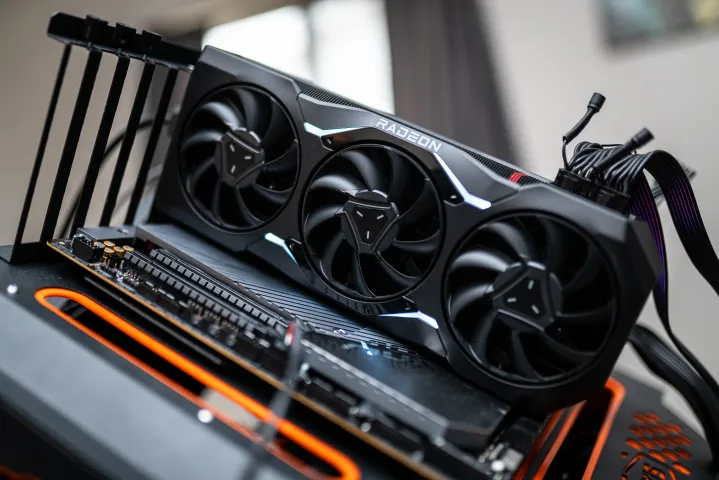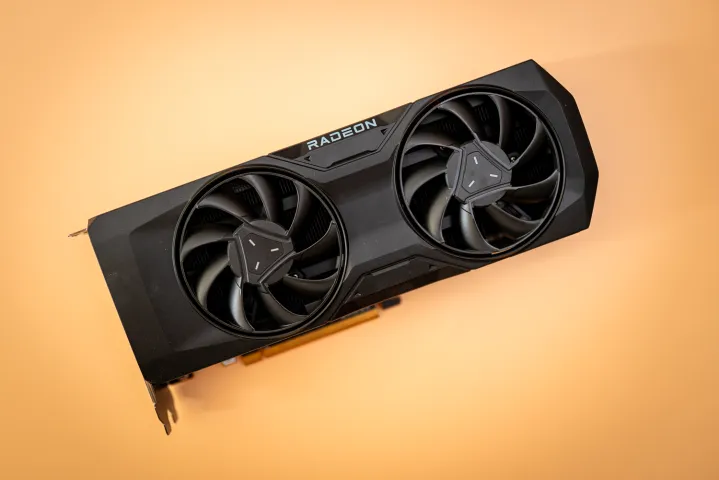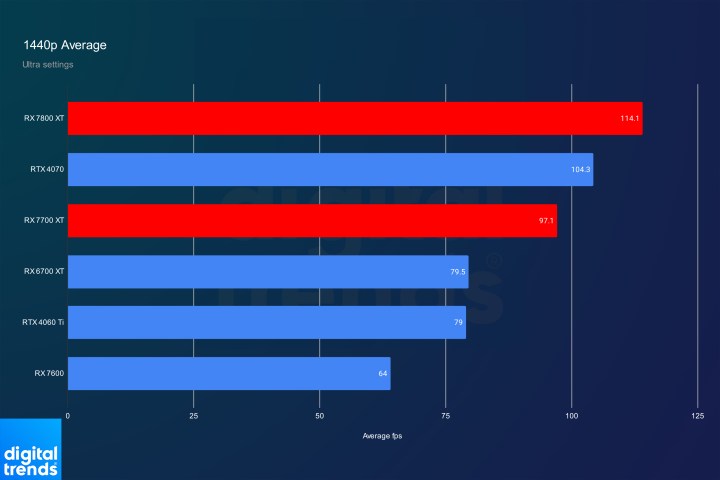
AMD’s new RX 7800 XT and RX 7700 XT are solid GPUs; let’s not get that twisted. However, they certainly aren’t great, with the RX 7700 XT coming in $50 more expensive than it should be, and the RX 7800 XT occasionally being beaten by last-gen’s RX 6800 XT. Sounds like a disaster.
So, why did I recommend the cards so highly in my RX 7800 XT and RX 7700 XT review? That largely comes down to Nvidia, and the “tierflation” we’ve seen over this generation (thanks u/Convextlc97 for the pointed description). It seems gamers agree, too, with the RX 7800 XT sold out nearly everywhere.
‘Tierflation’ at its finest

Let’s start with AMD because this criticism goes in both directions. At the start of the generation, AMD released the RX 7900 XTX and RX 7900 XT. There was no RX 6900 XTX, so the extra letter is a pretty clear example of pushing a GPU up a step in AMD’s lineup. Pure marketing. That wasn’t a problem, but with the new RX 7800 XT, there is an issue.
The RX 7800 XT isn’t a successor to the RX 6800 XT, as the name would have you think, and that’s true across both price and specs. The RX 6800 XT launched with a list price of $650, while the RX 7800 XT is releasing at $500. In addition, the RX 6800 XT has 72 RDNA 2 compute units, while the RX 7800 XT has 60 RDNA 3 compute units. That disparity is why some people are saying the RX 7800 XT provides basically no generational improvement, combined with the fact that retailers are selling off last-gen stock for bargain bin prices.
If you look at pricing and specs, the RX 7800 XT is a successor to the RX 6800, both of which have 60 compute units and were priced similarly at launch. The RX 6800 was a little more expensive at launch, but that was largely due to the rising tide of GPU prices during the shortage of yesteryear. With the RX 6800 around 10% to 15% behind the XT model, yeah, the RX 7800 XT is providing a generational improvement. Or, at the very least, it’s providing one if you compare list price and specs, not the name AMD chose to slap on the box.
AMD has said it’s done with new GPU dies, but something like an RX 7800 XTX (or, the true successor to the RX 6800 XT) isn’t out of the question. The RX 7800 XT is $500, and that leaves a massive gap in pricing up to AMD’s next GPU in its current-gen lineup, the RX 7900 XT.
Charge more, name less

Nvidia has done a lot more sliding around with its naming this generation, mainly just because it has released more GPUs than AMD has. The clearest example of that is the RTX 4070 Ti. This card, if you don’t remember, was originally announced as the 12GB RTX 4080 for $900. Understandably, there was an outcry, and Nvidia adjusted the name down to more closely align with the performance of the card.
Similarly, with the RTX 4060 Ti, Nvidia released an 8GB model for $400 and a 16GB model for $500. The performance of the 8GB RTX 4060 Ti was so poor that it was often beaten by last-gen’s RTX 3060 Ti. It’s a similar situation as the RX 7800 XT, where the name doesn’t align with the performance of the card. In the case of Nvidia, though, the price doesn’t align either.

Both AMD and Nvidia have been messing with their naming conventions this generation. AMD has only moved their cards up a step in naming, but most of Nvidia’s lineup has done the opposite: move the name down while charging more. Here’s a quick rundown of how Nvidia’s list prices for RTX 40-series compares to the previous generation:
- RTX 3090 ($1,500) — RTX 4090 ($1,600)
- RTX 3080 ($700) — RTX 4080 ($1,200)
- RTX 3070 Ti ($600) — RTX 4070 Ti ($800)
- RTX 3070 ($500) — RTX 4070 ($600)
- RTX 3060 Ti ($400) — RTX 4060 Ti ($400 or $500)
- RTX 3060 ($330) — RTX 4060 ($300)
Short of the RTX 4060, every one of Nvidia’s current-gen GPUs have gone up in price. They aren’t minor differences, either. The RTX 4080 is almost twice as expensive RTX 3080, and the RTX 4070 Ti is $200 more than the RTX 3070 Ti. And remember, with the RTX 4070 Ti, Nvidia originally planned on charging $900 for the GPU.
Either Nvidia isn’t naming its cards correctly, or it has obscenely raised its prices (a little bit of both, I suspect). The result has been a lukewarm reception to basically all new Nvidia releases. The company isn’t releasing bad GPUs — they’re very powerful and feature-rich — but they fall short of expectations because they aren’t named or priced correctly.
A free win

Now, AMD is hitting Nvidia where it hurts. AMD’s naming hasn’t aligned with performance, either, but it’s not raising prices. The RX 7800 XT and RX 7700 XT have a lower list price than their last-gen counterparts, even when you compare the specs and performance of the cards, not just the names AMD ran with. And that’s bad news for Nvidia’s lineup.
In the previous generation, AMD’s RX 6800 XT was competing with Nvidia’s RTX 3080. Nvidia universally outperformed AMD by a hair, but AMD’s card was a little cheaper ($650 compared to $700, at launch). This has been the established dynamic between AMD and Nvidia for the past few generations. AMD is a little cheaper, but Nvidia is a little faster, and with more features in tow.
This generation, Nvidia basically handed AMD a freebie with the RX 7800 XT and RX 7700 XT. Due to how expensive Nvidia’s current-gen GPUs are, AMD’s new cards are able to offer better performance while costing less than the competition from Nvidia. Of course, the RX 7700 XT beats an RTX 4060 Ti — AMD’s card was likely built to compete with the RTX 4070. The same is true of the RX 7800 XT, which would be clobbered by anything more powerful than the RTX 4070 it’s priced in accordance with.

You can extrapolate pricing to get a sense of what AMD was thinking here. If Nvidia kept the RTX 4070 at $500 like the previous generation, AMD’s RX 7700 XT at $450 would be a little slower, but also a little cheaper. It’s the same dynamic I laid out with the RX 6800 XT and RTX 3080 from last generation, just leaning heavier in Nvidia’s favor.
If it weren’t for Nvidia’s high pricing, the RX 7800 XT and RX 7700 XT would be middling at best, and downright bad at worst. They offer the bare minimum in generational upgrades, and Nvidia still runs away with ray tracing. If you have $500 to spend on a graphics card, though, it’s just not worth recommending anything else.
The hand gamers have been dealt this generation isn’t great, which is why I (and other reviewers) have so often pointed to last-gen options like the RX 6700 XT for gamers looking to upgrade. The RX 7800 XT and RX 7700 XT break that trend, and not because they’re great GPUs on their own. It’s just that the competition from Nvidia doesn’t hold up when you compare price and performance. This time around, at least, it’s a free win for AMD.




